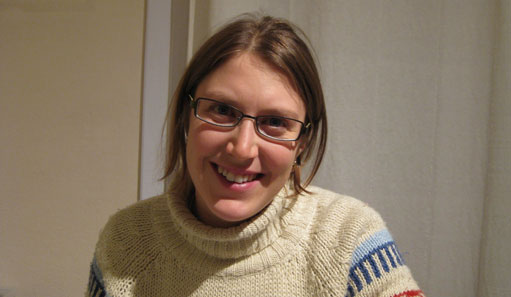
ATLAS e-News
23 February 2011
3 November 2008
Zuzana Zajacova
Nationality: Slovakian

Zuzana Zajacova
Zuzana Zajacova found her way to ATLAS through a slightly unusual route. Rather than being a particle physicist or engineer, she comes from a background of biomedical physics.
At Comenius University Bratislava, in her native Slovakia, she spent the first three years of her undergraduate degree taking courses in medicine, mathematics and physics, and the following two years focusing on radiotherapy, nuclear medicine and biomechanics. It was this combination of expertise which allowed her to specialise in radiation protection.
Zuzana got a taste for living abroad at age 16, when she spent one academic year studying in an American high school. During her undergraduate degree, she came to CERN as a summer student to work on radiation protection, and says that from that point on she was on the look-out for a way to come back.
Immediately after graduating, she spent a year working in pre-clinical biophysics research in Bratislava. Her project involved first manipulating DNA to isolate individual strands from their double helix arrangement, and then investigating the vibrational frequencies of quartz crystals attached to electrodes, to see whether these frequencies could be used as an accurate biosensor to detect one half of the “unzipped” DNA strands in solution.
But Zuzana was biding her time, looking out for opportunities to return to CERN. “I wanted to do my PhD abroad,” she says. “I stayed in touch with my summer student supervisor and arranged a project through him, then found a position at the Slovak University of Technology as my academic base.”
The project involved making predictions about the activation of ATLAS materials which will be immersed in the radiation field of the LHC proton-proton collisions. This is crucial information for planning maintenance operations; is it safe for a person to work there, and if so, for how long? “By predicting the radioactive nuclei that will be created, we can work out the kind of radiation we’ll be dealing with,” Zuzana explains.
Her three-year contract as a CERN doctoral student finished in November 2007, and she is now finishing up writing her thesis. But throughout this time she has found that she has had to tread a fine line between satisfying the requirements for a PhD qualification, like giving a conference presentation, and being sensitive to the fact that radiation is a contentious issue, misunderstood by the public at large.
Zuzana has an acute awareness of what she calls the “unjustly bad reputation” of radiation. When, as an undergraduate, she attended a public consultation held by the Slovak government over the installation of a small cyclotron for medical use, she left feeling frustrated: “I realised that there can be no discussion with a public that is afraid of radiation,” she says. “There was no reason involved, no rational thinking, only emotions. The public would not listen, only scream. And they can have a strong voice in these matters.”
This was in the back of her mind when she made her presentation in Atlanta, Georgia, USA, in April 2008. She focussed on explaining the methods of calculation used to qualitatively and quantitatively predict the radionuclei which will be created in the liquid argon used in one of the ATLAS calorimeters, rather than addressing radiological concerns.
Not only was it a tough assignment to step up to, but the Atlanta conference was also the first time Zuzana had ever had to give a formal public presentation. “Sometimes adrenaline brings the best of me, but sometimes it can paralyse me,” she says, admitting she wasn’t able to eat on the big day. She was obviously doing something right though, because the feedback she received from her audience was all positive.
Since then, Zuzana has become a CERN fellow and has taken a job with ATLAS. She has been working on radiation and radiological issues since September 2008, and is building on the work that she has already done by improving the detail in her calculations. “It is very iterative work – coming back to the problems that were already answered to a certain degree of resolution, and making these more accurate,” she explains.
Perhaps a little of this thinking has extended into her ongoing thesis write-up, which is still a work in progress. “The real deadline for it is the end of 2009. So in the back of my mind I always feel I have enough time, and I always want to make it better and better, and re-write it and re-write it!” she smiles.

Ceri PerkinsATLAS e-NEWS |